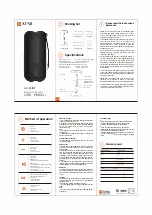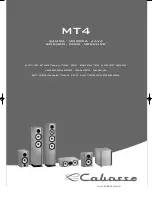
Tweeter diaphragm
Woofer diaphragm
Woofer suspension
Cabinet
Typical coaxial tweeter mounting
PowerPoint coaxial tweeter mounting
Shallow woofer diaphragm
Polystyrene
diaphragm
reinforcement
Rear mounted
suspension
Low diffraction
cabinet mounting
Typically, diffraction of the tweeter’s energy is caused by the woofer diaphragm’s deep
shape, its suspension, and the cabinet mounting.
The PowerPoint woofer’s shallow shape, rear mounted suspension, and cabinet
mounting all greatly reduce diffraction of the tweeter’s energy.
Frequency response
The graphs below show the frequency response of the
PowerPoint. The upper graph shows the (normal) on-axis
response and illustrates the very high degree of accuracy; no
frequency is overemphasized more than 3 dB or under-
emphasized more than 3 dB.
The second graph shows the on-axis, octave-averaged
response. This curve is representative of the speaker’s tonal
balance and shows that the PowerPoint is very accurately
balanced; any over or under emphasis is not more than 0.5 dB.
The third graph shows the 30
°
off-axis, octave averaged
response and illustrates that the speaker’s overall energy
response is well balanced, with no large depressions in any area
of the spectrum and only a gentle slope above 1 KHz that reaches
only -5 dB at 20 KHz. This high degree of uniformity is in part
the result of the PowerPoint’s first order crossover system.
Step response
The graph below shows the PowerPoint’s response to a step
signal. Notice that the overall triangular shape is very well
preserved with the output remaining smoothly positive until
1.3 ms when it finally crosses zero due to the fact that the bass
response extends to 75 Hz rather than DC. The irregularities
seen in the first few hundred microseconds are due to the tweeter
diaphragm resonance at the ultrasonic frequency of about
23 KHz. Waveform accuracy this good can only be achieved
with first order crossovers and time coherent driver positioning.
Time response
The energy-time response of the PowerPoint shows that the
speaker’s output quickly decays to -40 dB in 1.7 milliseconds,
indicating very clean inter-transient silence. Such performance is
the result of metal diaphragms that have no resonances within
their operating frequency range and strong, non-resonant
cabinet construction.
10K
Frequency
1K
25
20
15
10
5
0
-5
-10
100
20
20K
Amplitude — dB
Time – msec
0.5
1.0
Output
1.5
2.0
2.5
Time – msec
0.5
5
0
-5
-10
-15
-20
-25
-30
-35
1.0
Output — dB
1.5
2.0
2.5
Coaxial tweeter response
To maintain time coherence the tweeter must be aligned with
the woofer. There is usually a significant problem with the
response of tweeters which are mounted coaxially in a woofer.
Energy from the tweeter is reflected and diffracted from the
woofer’s diaphragm, suspension and cabinet and causes negative
effects on the tweeter’s output.
The PowerPoint’s woofer diaphragm shape has been
designed to greatly reduce negative effects on the tweeter’s
response. By shaping the diaphragm as a short tube opening into
a shallow flare, reflections are almost entirely eliminated. In
addition, the woofer’s surround is mounted to the rear of the
diaphragm such that the tweeter does not really “see” it as a
diffraction-causing obstruction. Also, the woofer is mounted
from the rear of the cabinet to obtain a smooth transition from
the woofer’s suspension to the cabinet.
All these features greatly reduce diffraction of the tweeter’s
energy as demonstrated by the following graphs. The first shows
the response of the PowerPoint’s tweeter in an infinite baffle and
the second graph shows the tweeter’s response when coaxially
mounted in a typical woofer. Irregularities can be seen above
4KHz caused by diffraction. The third graph show the response
in the PowerPoint to be much less altered than with typical
mounting.
Since the shape of the woofer’s diaphragm has been
optimized for the tweeter’s response rather than to minimize its
own resonances, it would not exhibit response as good as it
otherwise would. To remedy this problem the woofer diaphragm
is reinforced with very light and stiff molded polystyrene on its
rear surface. This reinforcement also provides the added benefit
of damping the high frequency diaphragm resonances somewhat.
10K
Frequency
1K
25
20
15
10
5
0
-5
-10
100
20
20K
Amplitude — dB
Tweeter response (curves offset 15 dB)
Infinite baffle, In conventional woofer, In shallow cone woofer






















